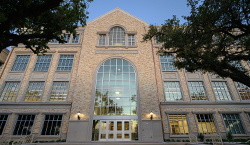Hundreds of Paraguay families call a landfill home, but they found hope through music when one man transformed an old colander into a violin.
March 05, 2019
Many of us have seen people take on a leadership role when that was not part of their formal role. In fact, their leadership is more noticeable precisely because it was not expected. They were so captured by what they wanted to achieve that they could not be stopped despite setbacks or obstacles or even personal risk.
The person who takes that first step may find that others are inspired to do likewise, creating a ripple effect across entire communities. The end result may be more impactful than was ever anticipated.
Consider the act of a single person in Cateura, Paraguay.
In Cateura, there is a community of 2,500 families living within the confines of a landfill.
A 2010 UNICEF report noted that more than 1,500 tons of trash are deposited in the landfill each day. The families who live there survive by searching for discarded items to sell – things that can be recycled or repurposed. The children of Cateura are often found working alongside their parents to find and resell whatever they can.
In 2006, Favio Chavez was hired to work on a recycling program at Cateura. Chavez, educated in environmental technology, also happens to be an amateur musician. He learned to play the guitar at an early age, and even as a child served as the choir director at his church. Seeing the plight of the children of Cateura, he determined to introduce music into their lives. Without resources to purchase musical instruments, he decided to begin in a very small way, by fashioning instruments from items found in the trash heaps of Cateura.
The first instrument was a violin made from a colander.
Inspired by his vision and seeing the possibilities, residents of Cateura also fashioned a wide variety of musical instruments from the contents of the landfill. The end result was the Recycled Orchestra, made up of talented and hardworking children and their unusual instruments, which has inspired and energized people worldwide.
And it all began with one man who wanted to bring the magic of music to children – and a violin made from a colander.
Leadership takes many forms, making it easy to see but hard to define. All around us we see people who step up to the needs in the world around them, who take action even when none is expected of them, who show others what is possible and thus spur them to action.
As Margaret Mead once said, “Never doubt that a small group of thoughtful, committed citizens can change the world. Indeed, it is the only thing that ever has.”
Your Turn
What would happen if you stepped forward into an unexpected act of leadership? Remember, by definition, these may be acts that almost anyone can accomplish. No special status, rank or privilege is required; only the vision to see a need and a desire to help meet that need.
- Identify a problem you want to help fix; a way to make your immediate world a better place. Look where you work, in your neighborhood or in your community. What opportunities do you notice?
- The challenges you have identified may seem too large for you to make a difference, but consider the following questions. Finding answers to even just one may help you see your way to an unexpected act of leadership.
- What small piece of this issue can I take ownership of?
- What can I do in my neighborhood, hometown, or other location to have a positive impact on this problem?
- Who can I partner with to increase the likelihood of success and the impact of our efforts?
- What resources (human, financial, material, etc.) do I have access to that can help solve this problem?
- Who can I consult with to help narrow my focus to a manageable piece of the problem and create a meaningful action plan?
- What talents, skills, knowledge or experience do I personally have that might help me to have a positive impact?
Puzzle Pieces
Vision is a powerful thing. If just one person has a vision, and acts on it, others will often see that they too can make a difference. At Cateura, one parent led the way by fashioning a violin from a colander, and soon others were creating musical instruments for their own children.
In his book Leading Change (1996), John Kotter describes the essential purposes served by a vision:
- First, it clarifies the general direction for change.
- Second, it motivates people to take action in the right direction.
- Lastly, it helps coordinate the actions of different people in a remarkably fast and efficient way.
We see all of these purposes enacted in the Cateura story. One person’s vision became everyone’s inspiration!
Recommended Reading
John P. Kotter (1996). Leading Change. Boston, MA: Harvard Business School Press.

